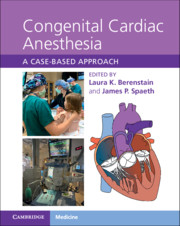Book contents
- Congenital Cardiac Anesthesia
- Congenital Cardiac Anesthesia
- Copyright page
- Dedication
- Contents
- Contributors
- Introduction
- Chapter 1 A Congenital Heart Disease Primer
- Section 1 Left-to-Right Shunts
- Section 2 Right-Sided Obstructive Lesions
- Section 3 Left-Sided Obstructive Lesions
- Chapter 14 Critical Aortic Stenosis
- Chapter 15 Aortic Stenosis
- Chapter 16 Subvalvular Aortic Stenosis
- Chapter 17 Supravalvular Aortic Stenosis
- Chapter 18 Hypertrophic Cardiomyopathy
- Chapter 19 Coarctation of the Aorta
- Chapter 20 Shone Complex
- Section 4 Complex Mixing Lesions
- Section 5 Single-Ventricle Physiology
- Section 6 Heart Failure, Mechanical Circulatory Support, and Transplantation
- Section 7 Miscellaneous Lesions and Syndromes
- Index
- References
Chapter 17 - Supravalvular Aortic Stenosis
from Section 3 - Left-Sided Obstructive Lesions
Published online by Cambridge University Press: 09 September 2021
- Congenital Cardiac Anesthesia
- Congenital Cardiac Anesthesia
- Copyright page
- Dedication
- Contents
- Contributors
- Introduction
- Chapter 1 A Congenital Heart Disease Primer
- Section 1 Left-to-Right Shunts
- Section 2 Right-Sided Obstructive Lesions
- Section 3 Left-Sided Obstructive Lesions
- Chapter 14 Critical Aortic Stenosis
- Chapter 15 Aortic Stenosis
- Chapter 16 Subvalvular Aortic Stenosis
- Chapter 17 Supravalvular Aortic Stenosis
- Chapter 18 Hypertrophic Cardiomyopathy
- Chapter 19 Coarctation of the Aorta
- Chapter 20 Shone Complex
- Section 4 Complex Mixing Lesions
- Section 5 Single-Ventricle Physiology
- Section 6 Heart Failure, Mechanical Circulatory Support, and Transplantation
- Section 7 Miscellaneous Lesions and Syndromes
- Index
- References
Summary
Williams syndrome is a multisystem disorder with a variable clinical presentation resulting from a chromosome 7q11.23 microdeletion including the ELN gene coding for the protein elastin. Eighty percent of patients have cardiovascular abnormalities including supravalvar aortic stenosis, branch and peripheral pulmonary artery stenosis, and coronary artery obstructions. Patients are at high risk for cardiac arrest when undergoing sedation or general anesthesia due to an imbalance in myocardial oxygen supply and demand induced by anesthetic medications. Risk factors for cardiac arrest in the perioperative period are biventricular outflow tract obstruction and coronary artery obstruction by ostial or intraluminal stenosis. Hemodynamic goals include maintaining an age-appropriate heart rate, sinus rhythm, preload, contractility, and systemic vascular resistance. Sedation or general anesthesia for elective procedures should be performed at tertiary care medical centers with immediate access to cardiac specialists and the capability to provide extracorporeal membrane oxygenation support.
Keywords
- Type
- Chapter
- Information
- Congenital Cardiac AnesthesiaA Case-based Approach, pp. 105 - 112Publisher: Cambridge University PressPrint publication year: 2021



